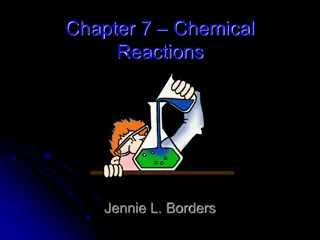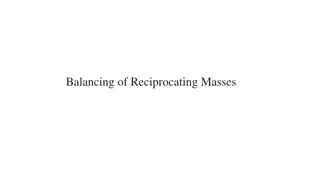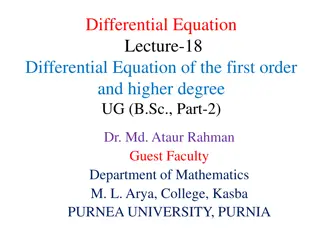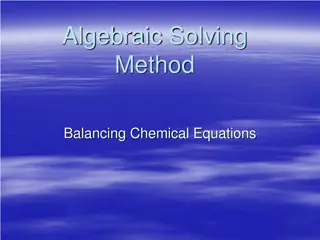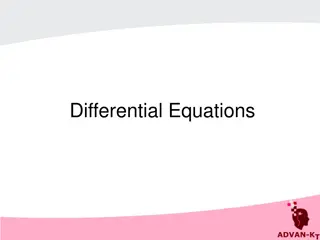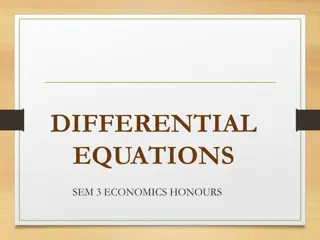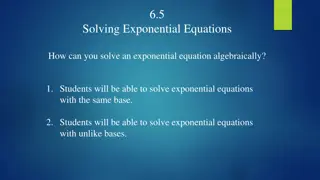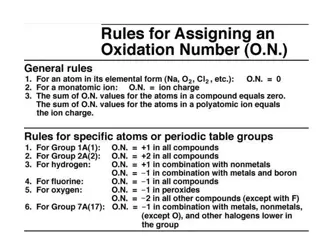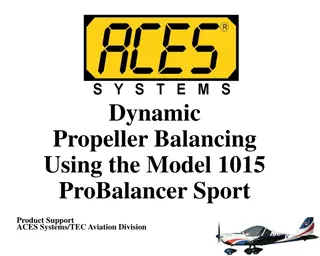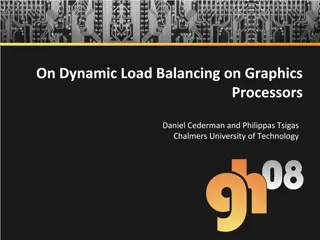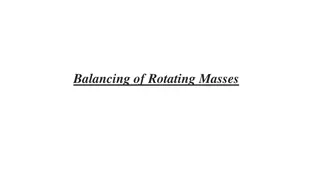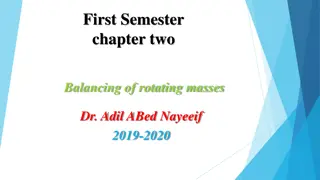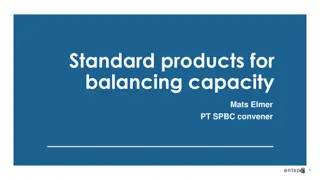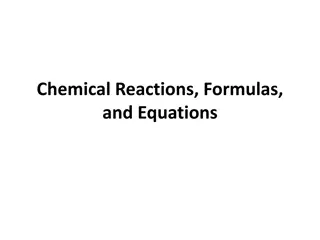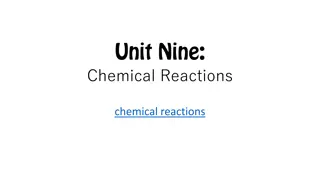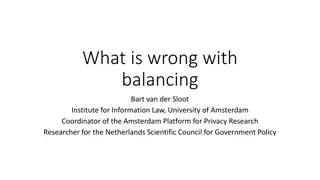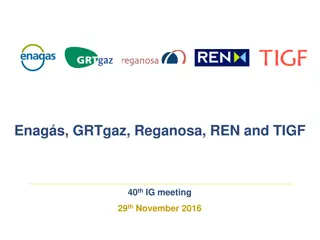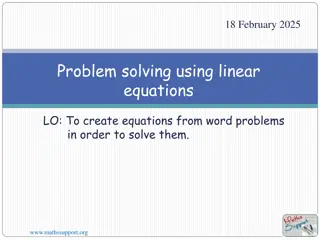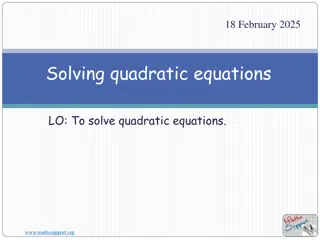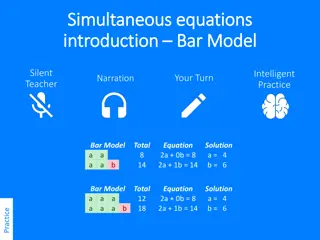Chemical Reactions: Reactants, Products, and Balancing Equations
Chemical reactions involve reactants that transform into products. Balancing equations is essential to ensure the conservation of mass. Learn about decomposition reactions, chemical equations, and methods to balance equations effectively.
7 views • 39 slides
Numerical Methods for Approximating Analytic Equations
Introduction to approximating solutions to analytic equations, focusing on differential equations, integral equations, and integro-differential equations. Exploring ordinary and partial derivatives, differential and integral equations, and the involvement of unknown functions and their derivatives a
8 views • 15 slides
Balancing of Reciprocating Masses in Engines
Learn about the balancing of reciprocating masses in engines, including the importance of balancing primary and secondary forces in multi-cylinder in-line engines. Discover how crank angles and cylinder arrangements contribute to balancing forces for optimal engine performance.
3 views • 6 slides
Differential Equations of First Order & Higher Degree: Lecture 18
This lecture covers differential equations of first order but not of the first degree, general forms of such equations, methods for solving them, and examples of differential equations to be solved. The content includes detailed explanations, equations, solutions, and problem-solving techniques.
14 views • 9 slides
Balancing Chemical Equations Using Algebraic Solving Method
Learn how to balance chemical equations using the algebraic solving method step-by-step by assigning variables to compounds and solving for each variable. This comprehensive guide takes you through the entire process, from assigning variables to simplifying fractions and substituting values back int
4 views • 9 slides
Differential Equations: Types, Classification, and Solutions
Differential equations are mathematical equations that relate independent and dependent variables through differential coefficients. They can be classified as ordinary or partial, based on the types of derivatives involved. The order and degree of a differential equation, as well as its linearity an
10 views • 26 slides
Differential Equations in Economics Honours
Differential equations, introduced by Newton and Leibniz in the 17th century, play a key role in economics. These equations involve derivatives and represent implicit functional relationships between variables and their differentials, often related to time functions. The order and degree of a differ
4 views • 16 slides
Introduction to Differential Equations and Laplace Equations
Understanding differential equations of various orders, solving methods, linear and non-linear equations, ordinary and partial differential equations, definitions of solutions, and general vs. particular solutions in the context of Differential Equations and Laplace Equations.
8 views • 20 slides
Roadmap for DNS Load Balancing Service at CERN - HEPiX Autumn 2020 Workshop
This roadmap presented by Kristian Kouros on behalf of the DNS Load Balancing Team at CERN outlines the introduction, implementation, and upgrades associated with the DNS Load Balancing Service. It covers topics such as system architecture, LBClient metrics, and the overall structure of the service.
10 views • 29 slides
Solving Exponential Equations Algebraically
Learn how to solve exponential equations algebraically with the same base and unlike bases. Understand the properties of equality for exponential equations and practice solving various equations step by step. Improve your skills in rewriting equations with the same base and applying the rules of exp
3 views • 9 slides
Redox Reactivity and Balancing Equations in Acidic Solutions
Exploring the concept of reactivity in redox reactions using zinc, nickel, and copper, followed by a detailed guide on balancing redox equations in acidic solutions. Learn how to determine oxidation numbers, identify redox atoms, balance charges, and handle oxygen and hydrogen atoms to achieve balan
5 views • 18 slides
Dynamic Propeller Balancing with ProBalancer Sport
Explore the importance of dynamic propeller balancing using the Model 1015 ProBalancer Sport. Learn about vibration basics, balancing benefits, and fundamentals of using the ProBalancer Sport for propeller balancing. Discover how vibration affects aircraft components, leading to issues like engine f
5 views • 68 slides
GCSE Algebra Revision Materials and Equations Practice
Explore a collection of GCSE algebra revision materials, including solving linear equations and common mishaps in algebraic simplification. Practice setting up equations and solving linear equations with provided examples and questions. Enhance your algebra skills through comprehensive content desig
3 views • 15 slides
Dynamic Load Balancing on Graphics Processors: A Detailed Study
In this comprehensive study by Daniel Cederman and Philippas Tsigas from Chalmers University of Technology, the focus is on dynamic load balancing on graphics processors. The research delves into the motivation, methods, experimental evaluations, and conclusions related to this critical area. It cov
1 views • 57 slides
GreedyLB and RefineLB Load Balancing Strategies
Explore the GreedyLB and RefineLB load balancing algorithms, their implementation steps, utilization before and after load balancing, object migration statistics, and cost considerations. Learn how the strategies optimize the mapping of objects to processors for efficient load balancing.
7 views • 21 slides
Dynamic Load Balancing in Block-Sparse Tensor Contractions
This paper discusses load balancing algorithms for block-sparse tensor contractions, focusing on dynamic load balancing challenges and implementation strategies. It explores the use of Global Arrays (GA), performance experiments, Inspector/Executor design, and dynamic buckets implementation to optim
4 views • 32 slides
The Balancing of Rotating Masses in Machinery
Balancing rotating masses in machinery is crucial for optimal performance. The article covers different methods such as balancing with single and multiple masses in various planes, both graphically and analytically. Proper balancing helps reduce vibrations and ensures the smooth operation of high-sp
15 views • 9 slides
Balancing of Rotating Masses in Engineering
Balancing of rotating masses is crucial in engineering to prevent the effects of centrifugal force, vibrations, and shaft bending. The process involves attaching balancing masses to counteract the centrifugal forces of the primary masses. Different cases, such as balancing in the same plane or diffe
0 views • 24 slides
Chemical Reactions and Stoichiometry in AP Chemistry
Chemical reactions involving stoichiometry play a crucial role in AP Chemistry. Understanding how atoms are rearranged, mass is conserved, and energy is exchanged is essential for balancing chemical equations. Examples include the thermite reaction, combustion of methane, and reactions like synthesi
2 views • 38 slides
Stakeholders Concerns and Feedback on Balancing Capacity Standard Products
General stakeholders' concerns and feedback on standard products for balancing capacity, as outlined in the Mats Elmer PT SPBC convener's proposal, are highlighted. The proposal aims to support a level playing field for balancing capacity cooperation, welcome all technologies, and respect EB.GL requ
0 views • 8 slides
Chemical Reactions, Formulas, and Equations
Explore the world of chemical reactions, formulas, and equations with insights into signs of reactions, chemical structure representation, and the balance of reactants and products in equations. Learn about how new substances are formed and the role of coefficients in balancing equations.
4 views • 5 slides
Chemical Reactions in Daily Life
Understanding chemistry, particularly chemical reactions, is crucial for our daily lives. Chemical reactions involve the transformation of substances into different ones, described by reactants and products in equations. By learning about chemical equations, word equations, formula equations, and th
5 views • 15 slides
The Problem with Balancing in Legal and Ethical Frameworks
The content discusses the limitations and drawbacks of the concept of balancing in legal and ethical contexts, focusing on the theoretical instability, moral implications, and intellectual laziness associated with it. Using the example of the Delfi case, it highlights the challenges and conflicts ar
4 views • 18 slides
Gas Interconnection Agreements and Balancing Implementation Insights
Gas industry stakeholders Enags, GRTgaz, Reganosa, REN, and TIGF collaborated on various public consultations and discussed the implementation of Balancing Network Codes. Key topics include interconnection agreements, exceptional event situations, local products for balancing services, and the publi
3 views • 13 slides
Geometric Discrepancy Theory: Online Vector Balancing & Interval Balancing Study
Study covers online geometric discrepancy theory with applications in fair division, focusing on vector balancing, interval balancing, and Tusnady's problem. Concepts explored include offline vs online approaches, interval balancing techniques, and linear algebraic views.
3 views • 29 slides
Problem-Solving with Linear Equations
Learn how to create and solve equations from word problems involving linear equations. Follow six steps: define the unknown, determine operations, translate into an equation, solve by isolating the unknown, check the solution, and present the answer in sentence form. Step through examples of constru
2 views • 11 slides
Solving quadratic equations
Quadratic equations are solved by finding the values of x that satisfy the equation ax^2 + bx + c = 0. This post covers the general form of quadratic equations, examples, and step-by-step solutions for equations like x( x + 4) = 0 or ( x - 5)^2 = 0. Learn how to rearrange equations for solving and u
1 views • 15 slides
Balancing Chemical Equations Practice
In this practice exercise, you will explore balancing chemical equations involving reactions between different elements and ions. Follow the step-by-step process to balance the equations correctly, ensuring conservation of mass and charge. Utilize the provided examples and images to enhance your und
2 views • 66 slides
Chemical Formulae and Balancing Equations
In this material, you will learn about constructing chemical compounds like Sodium Chloride, Magnesium Chloride, and more using provided elements. Also, practice balancing equations involving various chemicals. Explore the world of chemical formulas and equations with visual aids.
0 views • 32 slides
Chemical Equations and Conservation of Mass
Today's lesson focuses on the law of conservation of mass in chemical reactions. Students will explore balancing equations through practical activities. They will learn to represent reactions accurately and check if reactions comply with the conservation law. Hands-on tasks involving colored blocks
55 views • 12 slides
Scalable Load Balancing Using Programmable Data Planes
HULA is a scalable load balancing solution that leverages programmable data planes to efficiently manage traffic in data centers. It addresses challenges such as multiple network paths, high bisection bandwidth, volatile traffic, and serving multiple tenants. With a focus on optimizing path performa
2 views • 34 slides
Solving Simultaneous Equations with Bar Models and Practice
This content covers the introduction to simultaneous equations, using bar models to represent equations, practicing solving simultaneous equations step-by-step, and providing worked examples for better understanding. It includes equations with various coefficients and multiple variables, followed by
11 views • 8 slides
Chemical Reactions and Balancing Equations Explained
Learn about chemical reactions, reactants, products, writing equations, balancing equations following the law of conservation of mass, and writing balanced chemical equations for various reactions like calcium nitrate and sodium hydroxide, copper (II) chloride with aluminum metal. Understand the pro
2 views • 7 slides
Chemical Reactions: Understanding Equations and Types
Explore the fundamentals of chemical reactions, including balancing equations, types of reactions, and examples. Learn about reactants, products, the law of conservation of mass, and the role of catalysts. Try your hand at balancing equations for various reactions.
3 views • 24 slides
Balancing Chemical Equations and Conservation of Mass
Explore the concept of balancing chemical equations and conservation of mass through examples and challenges. Learn about the number of atoms in compounds and practice balancing symbol equations. Discover the law of conservation of mass and its application in chemical reactions. Challenge yourself w
3 views • 12 slides
Differential Equations: Equations, Solutions, and Types
Explore the world of differential equations, from general first-order equations to Clairaut's equation and partial differential equations. Learn how to form, solve, and understand different types of equations with varying degrees and orders.
7 views • 20 slides
Chemical Reactions and Stoichiometry
Stoichiometry involves studying the quantities of substances consumed and produced in chemical reactions. The Law of Conservation of Mass states that matter is neither created nor destroyed in a chemical reaction. Balancing equations is essential to ensure the conservation of mass. This content disc
2 views • 42 slides
Understanding Chemical Reactions and Balancing Equations
Learn about chemical reactions, Dalton's atomic theory, and the importance of balancing chemical equations. Discover how to represent reactions as equations, understand coefficients, and why balancing is necessary to maintain the law of conservation of mass.
3 views • 18 slides
Chemical Equations and Balancing Reactions in Chemistry
Learn about chemical reactions through the symbolic representation of chemical equations, understand the importance of balancing equations to satisfy the law of conservation of mass, and explore strategies for balancing reactions effectively.
1 views • 10 slides
Chemical Reactions and Balancing Equations Guide
Explore the world of chemical reactions and learn how to balance equations with this comprehensive guide, covering evidence of chemical reactions, chemical equation notation, balancing techniques, and helpful tips and examples. Enhance your understanding of balancing chemical equations and master th
1 views • 14 slides
